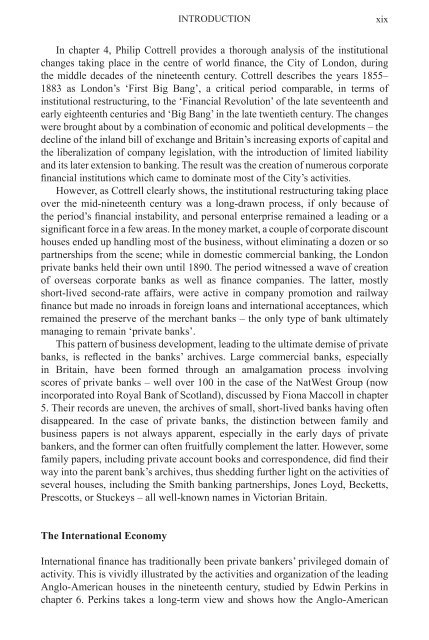the world of private banking
the world of private banking
the world of private banking
Create successful ePaper yourself
Turn your PDF publications into a flip-book with our unique Google optimized e-Paper software.
INtRODUctION<br />
xix<br />
In chapter 4, Philip Cottrell provides a thorough analysis <strong>of</strong> <strong>the</strong> institutional<br />
changes taking place in <strong>the</strong> centre <strong>of</strong> <strong>world</strong> finance, <strong>the</strong> City <strong>of</strong> London, during<br />
<strong>the</strong> middle decades <strong>of</strong> <strong>the</strong> nineteenth century. Cottrell describes <strong>the</strong> years 1855–<br />
1883 as London’s ‘First Big Bang’, a critical period comparable, in terms <strong>of</strong><br />
institutional restructuring, to <strong>the</strong> ‘Financial Revolution’ <strong>of</strong> <strong>the</strong> late seventeenth and<br />
early eighteenth centuries and ‘Big Bang’ in <strong>the</strong> late twentieth century. The changes<br />
were brought about by a combination <strong>of</strong> economic and political developments – <strong>the</strong><br />
decline <strong>of</strong> <strong>the</strong> inland bill <strong>of</strong> exchange and Britain’s increasing exports <strong>of</strong> capital and<br />
<strong>the</strong> liberalization <strong>of</strong> company legislation, with <strong>the</strong> introduction <strong>of</strong> limited liability<br />
and its later extension to <strong>banking</strong>. The result was <strong>the</strong> creation <strong>of</strong> numerous corporate<br />
financial institutions which came to dominate most <strong>of</strong> <strong>the</strong> City’s activities.<br />
However, as Cottrell clearly shows, <strong>the</strong> institutional restructuring taking place<br />
over <strong>the</strong> mid-nineteenth century was a long-drawn process, if only because <strong>of</strong><br />
<strong>the</strong> period’s financial instability, and personal enterprise remained a leading or a<br />
significant force in a few areas. In <strong>the</strong> money market, a couple <strong>of</strong> corporate discount<br />
houses ended up handling most <strong>of</strong> <strong>the</strong> business, without eliminating a dozen or so<br />
partnerships from <strong>the</strong> scene; while in domestic commercial <strong>banking</strong>, <strong>the</strong> London<br />
<strong>private</strong> banks held <strong>the</strong>ir own until 1890. The period witnessed a wave <strong>of</strong> creation<br />
<strong>of</strong> overseas corporate banks as well as finance companies. The latter, mostly<br />
short-lived second-rate affairs, were active in company promotion and railway<br />
finance but made no inroads in foreign loans and international acceptances, which<br />
remained <strong>the</strong> preserve <strong>of</strong> <strong>the</strong> merchant banks – <strong>the</strong> only type <strong>of</strong> bank ultimately<br />
managing to remain ‘<strong>private</strong> banks’.<br />
This pattern <strong>of</strong> business development, leading to <strong>the</strong> ultimate demise <strong>of</strong> <strong>private</strong><br />
banks, is reflected in <strong>the</strong> banks’ archives. Large commercial banks, especially<br />
in Britain, have been formed through an amalgamation process involving<br />
scores <strong>of</strong> <strong>private</strong> banks – well over 100 in <strong>the</strong> case <strong>of</strong> <strong>the</strong> NatWest Group (now<br />
incorporated into Royal Bank <strong>of</strong> Scotland), discussed by Fiona Maccoll in chapter<br />
5. Their records are uneven, <strong>the</strong> archives <strong>of</strong> small, short-lived banks having <strong>of</strong>ten<br />
disappeared. In <strong>the</strong> case <strong>of</strong> <strong>private</strong> banks, <strong>the</strong> distinction between family and<br />
business papers is not always apparent, especially in <strong>the</strong> early days <strong>of</strong> <strong>private</strong><br />
bankers, and <strong>the</strong> former can <strong>of</strong>ten fruitfully complement <strong>the</strong> latter. However, some<br />
family papers, including <strong>private</strong> account books and correspondence, did find <strong>the</strong>ir<br />
way into <strong>the</strong> parent bank’s archives, thus shedding fur<strong>the</strong>r light on <strong>the</strong> activities <strong>of</strong><br />
several houses, including <strong>the</strong> Smith <strong>banking</strong> partnerships, Jones Loyd, Becketts,<br />
Prescotts, or Stuckeys – all well-known names in Victorian Britain.<br />
The International Economy<br />
International finance has traditionally been <strong>private</strong> bankers’ privileged domain <strong>of</strong><br />
activity. This is vividly illustrated by <strong>the</strong> activities and organization <strong>of</strong> <strong>the</strong> leading<br />
Anglo-American houses in <strong>the</strong> nineteenth century, studied by Edwin Perkins in<br />
chapter 6. Perkins takes a long-term view and shows how <strong>the</strong> Anglo-American












![[Pham_Sherisse]_Frommer's_Southeast_Asia(Book4You)](https://img.yumpu.com/38206466/1/166x260/pham-sherisse-frommers-southeast-asiabook4you.jpg?quality=85)



